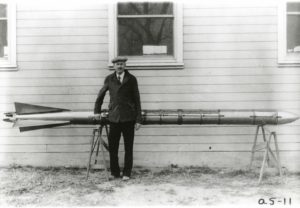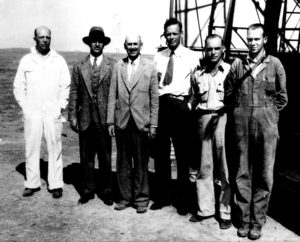28 March 1935: Near Roswell, New Mexico, Robert H. Goddard successfully launched the first gyroscopically-stabilized liquid-fueled rocket. In a 20-second flight, the A-Series rocket, number A-5, reached an altitude of 4,800 feet (1,463 meters) and traveled 13,000 feet (3,962 meters) downrange. Its speed was 550 miles per hour (885 kilometers per hour). During the flight, the rocket corrected its flight path several times. 
The A-Series rockets were of varying lengths and mass. The representative A-series rocket displayed at the National Air and Space Museum is 15 feet, 4½ inches (468.63 centimeters) long with a diameter of 9 inches (22.86 centimeters). The span across the fins is 1 foot, 9½ inches (54.61 centimeters). It weighs 78.5 pounds (35.6 kilograms). The rocket was fueled with gasoline and liquid oxygen, pressurized with nitrogen.
A gyroscope controlled vanes placed in the engine’s exhaust, providing stabilization during powered flight.
Goddard flew the A-series 14 times between 15 January and 29 October 1935.

Goddard is the “Father of Modern Rocketry.” Many of his developments were copied by German engineers as they developed the V2 rocket of World War II. And this led to America’s own post-War rocket developments, including the mighty Saturn V moon rocket.
